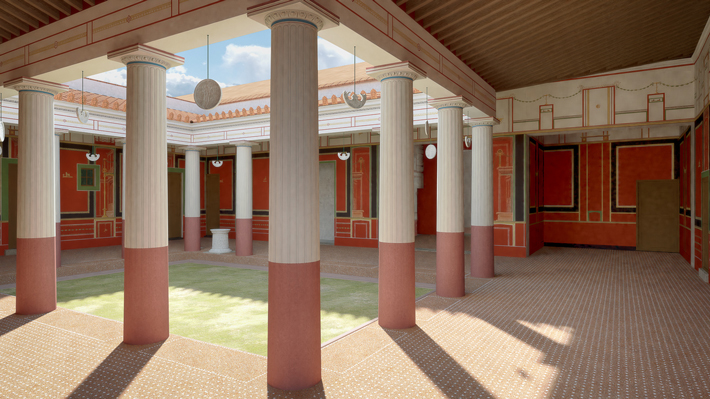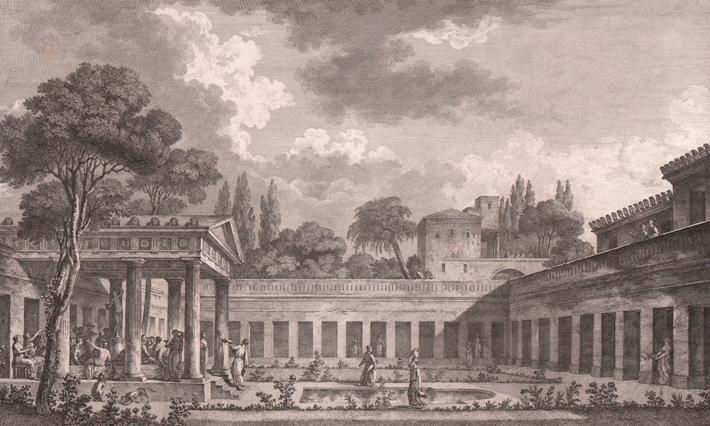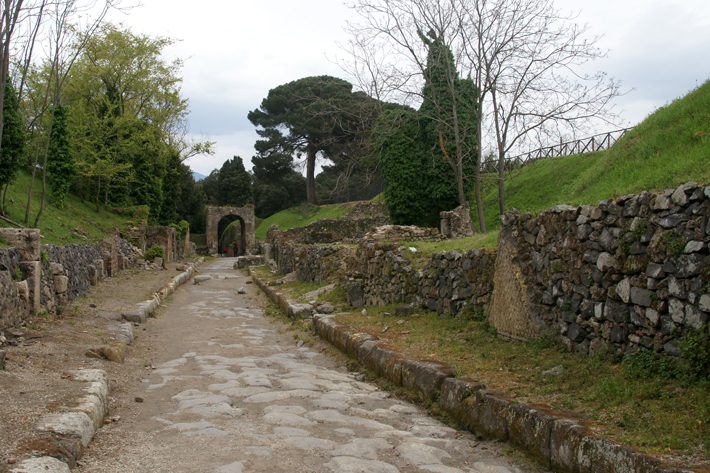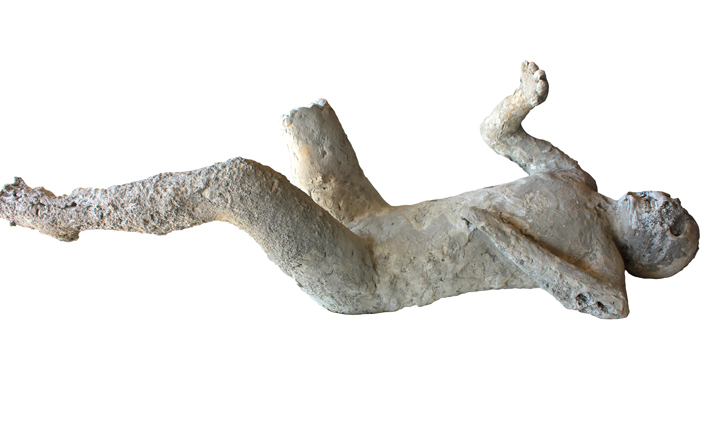Pompeii
The Upper Class
Monday, June 10, 2019
 Like most urban areas, ancient Pompeii had residences of all types, including sprawling villas, smaller city houses, and multistory apartment buildings. Few of its homes, however, were as grand as the Villa of Diomedes. “The Villa of Diomedes combines the characteristics of a city dwelling where a wealthy family lived and received guests, and all the attractions of a seaside villa spread over 40,000 square feet with a panoramic view of the Bay of Naples,” says archaeologist Hélène Dessales of the École normale supérieure of Paris. It was also one of the first properties in Pompeii to be excavated when, between 1771 and 1775, Francesco La Vega, an engineer serving Charles of Bourbon, the king of Naples, explored the property.
Like most urban areas, ancient Pompeii had residences of all types, including sprawling villas, smaller city houses, and multistory apartment buildings. Few of its homes, however, were as grand as the Villa of Diomedes. “The Villa of Diomedes combines the characteristics of a city dwelling where a wealthy family lived and received guests, and all the attractions of a seaside villa spread over 40,000 square feet with a panoramic view of the Bay of Naples,” says archaeologist Hélène Dessales of the École normale supérieure of Paris. It was also one of the first properties in Pompeii to be excavated when, between 1771 and 1775, Francesco La Vega, an engineer serving Charles of Bourbon, the king of Naples, explored the property.
 La Vega kept careful records of his work, and Grand Tour artists drew and sold scenes of the villa. Paradoxically, though, explains Dessales, while it has been one of the most widely represented buildings in Pompeii for more than 250 years, the Villa of Diomedes’ 2,000-year-plus history from its foundation through A.D. 79 to the present has never been comprehensively understood. For the past seven years, Dessales has supervised an international project that has taken more than 25,000 new photographs and used software to combine these modern images with more than 350 archival ones showing the villa at different times since its discovery. They have created the first highly detailed 3-D model of a residential property in Pompeii.
La Vega kept careful records of his work, and Grand Tour artists drew and sold scenes of the villa. Paradoxically, though, explains Dessales, while it has been one of the most widely represented buildings in Pompeii for more than 250 years, the Villa of Diomedes’ 2,000-year-plus history from its foundation through A.D. 79 to the present has never been comprehensively understood. For the past seven years, Dessales has supervised an international project that has taken more than 25,000 new photographs and used software to combine these modern images with more than 350 archival ones showing the villa at different times since its discovery. They have created the first highly detailed 3-D model of a residential property in Pompeii.

Death
Monday, June 10, 2019
 One of the most interesting cemeteries lining the well-traveled roads connecting Pompeii with the surrounding area was first identified more than 100 years ago just outside the Porta Nola, the gate leading to the city of Nola. “The Porta Nola necropolis is fascinating because it gives us the opportunity to look at a wide section of society,” says archaeologist Stephen Kay of the British School at Rome, who, alongside Llorenç Alapont of the European University of Valencia and Rosa Albiach of the Valencia Museum of Illustration and Modernity, leads a team that has been reinvestigating the burial ground. “We have very high-status monumental tombs such as the one belonging to Marcus Obellius Firmus, a member of one of Pompeii’s richest families, and a uniquely Pompeian style of semicircular tomb belonging to a woman named Aesquillia Polla,” Kay says.
One of the most interesting cemeteries lining the well-traveled roads connecting Pompeii with the surrounding area was first identified more than 100 years ago just outside the Porta Nola, the gate leading to the city of Nola. “The Porta Nola necropolis is fascinating because it gives us the opportunity to look at a wide section of society,” says archaeologist Stephen Kay of the British School at Rome, who, alongside Llorenç Alapont of the European University of Valencia and Rosa Albiach of the Valencia Museum of Illustration and Modernity, leads a team that has been reinvestigating the burial ground. “We have very high-status monumental tombs such as the one belonging to Marcus Obellius Firmus, a member of one of Pompeii’s richest families, and a uniquely Pompeian style of semicircular tomb belonging to a woman named Aesquillia Polla,” Kay says.
Excavations at the Porta Nola have, in addition, uncovered simple cremation burials of poorer Pompeians that Kay’s team has now associated with a series of Greek names inscribed on the city walls. The necropolis also contains four graves of members of the Praetorian Guard, elite soldiers who served as the emperor’s household troops and bodyguards. Each grave was marked by an inscribed marble slab called a columella, and contains a selection of artifacts. The guards’ burials were first excavated in the 1970s, and the team has now uncovered the ceramic cremation urns containing all the soldiers’ remains.
 Another notable group of Pompeii’s dead is also represented at the Porta Nola: 15 people who were killed by the eruption and preserved in plaster casts made of their bodies during the twentieth-century excavations. Kay and his team are now examining the preserved skeletons inside the casts to see what they might be able to tell about the sort of people who lived and worked in the Porta Nola neighborhood. Says Kay, “These people are an important part of the city and its history of death.”
Another notable group of Pompeii’s dead is also represented at the Porta Nola: 15 people who were killed by the eruption and preserved in plaster casts made of their bodies during the twentieth-century excavations. Kay and his team are now examining the preserved skeletons inside the casts to see what they might be able to tell about the sort of people who lived and worked in the Porta Nola neighborhood. Says Kay, “These people are an important part of the city and its history of death.”

The Eruption's Aftermath
Monday, June 10, 2019
 Thousands of people perished in the eruption of Mount Vesuvius, but many Pompeians managed to flee the city and the volcano’s blast zone. For 30 years, the question of where these survivors went has intrigued archaeologist Steven Tuck of Miami University of Ohio. One source of evidence he has explored is the existence of massive building projects undertaken by the emperor Domitian in the nearby cities of Naples, Cumae, and Puteoli in the years after the eruption. “Whole neighborhoods, suburbs, roads, aqueducts, water systems, amphitheaters—all of the infrastructure for an urban community—was poured into these communities on the Bay of Naples by the imperial government,” Tuck says.
Thousands of people perished in the eruption of Mount Vesuvius, but many Pompeians managed to flee the city and the volcano’s blast zone. For 30 years, the question of where these survivors went has intrigued archaeologist Steven Tuck of Miami University of Ohio. One source of evidence he has explored is the existence of massive building projects undertaken by the emperor Domitian in the nearby cities of Naples, Cumae, and Puteoli in the years after the eruption. “Whole neighborhoods, suburbs, roads, aqueducts, water systems, amphitheaters—all of the infrastructure for an urban community—was poured into these communities on the Bay of Naples by the imperial government,” Tuck says.
To trace the relocation of individual survivors to these and other towns in the area, Tuck scoured inscriptions from pre-eruption Pompeii for distinct Roman family names. He then identified these same names in inscriptions in communities where refugees may have moved after A.D. 79. Tuck has concluded that survivors seem to have resettled in cities where they had social and economic opportunities, rather than where their blood relatives lived. Still, many Pompeian survivors maintained ties to their city in their new communities, particularly through marriage to other Pompeians. For example, a late first-century A.D. inscription found in Naples reads:
To the spirits of the dead
Farewell Vettia Sabina
you who lived ever so well.
Marcus Tullius Dionysius
to his dearest wife
who lived 24 years, 3 months, 22 days
Tullius and Sabinus (the male version of Sabina) are both well-known Pompeian family names. This inscription also contains the only known example from Naples of have, a word that in the Oscan language of Pompeii’s pre-Roman settlers means both “greetings” and “farewell.”

Advertisement
Advertisement
IN THIS ISSUE
Advertisement

Recent Issues
-
 May/June 2024
May/June 2024
-
 March/April 2024
March/April 2024
-
 January/February 2024
January/February 2024
-
 November/December 2023
November/December 2023
-
 September/October 2023
September/October 2023
-
 July/August 2023
July/August 2023
-
 May/June 2023
May/June 2023
-
 March/April 2023
March/April 2023
-
 January/February 2023
January/February 2023
-
 November/December 2022
November/December 2022
-
 September/October 2022
September/October 2022
-
 July/August 2022
July/August 2022
-
 May/June 2022
May/June 2022
-
 March/April 2022
March/April 2022
-
 January/February 2022
January/February 2022
-
 November/December 2021
November/December 2021
-
 September/October 2021
September/October 2021
-
 July/August 2021
July/August 2021
-
 May/June 2021
May/June 2021
-
 March/April 2021
March/April 2021
-
 January/February 2021
January/February 2021
-
 November/December 2020
November/December 2020
-
 September/October 2020
September/October 2020
-
 July/August 2020
July/August 2020
-
 May/June 2020
May/June 2020
-
 March/April 2020
March/April 2020
-
 January/February 2020
January/February 2020
-
 November/December 2019
November/December 2019
-
 September/October 2019
September/October 2019
-
 July/August 2019
July/August 2019
-
 May/June 2019
May/June 2019
-
 March/April 2019
March/April 2019
-
 January/February 2019
January/February 2019
-
 November/December 2018
November/December 2018
-
 September/October 2018
September/October 2018
-
 July/August 2018
July/August 2018
-
 May/June 2018
May/June 2018
-
 March/April 2018
March/April 2018
-
 January/February 2018
January/February 2018
-
 November/December 2017
November/December 2017
-
 September/October 2017
September/October 2017
-
 July/August 2017
July/August 2017
-
 May/June 2017
May/June 2017
-
 March/April 2017
March/April 2017
-
 January/February 2017
January/February 2017
-
 November/December 2016
November/December 2016
-
 September/October 2016
September/October 2016
-
 July/August 2016
July/August 2016
-
 May/June 2016
May/June 2016
-
 March/April 2016
March/April 2016
-
 January/February 2016
January/February 2016
-
 November/December 2015
November/December 2015
-
 September/October 2015
September/October 2015
-
 July/August 2015
July/August 2015
-
 May/June 2015
May/June 2015
-
 March/April 2015
March/April 2015
-
 January/February 2015
January/February 2015
-
 November/December 2014
November/December 2014
-
 September/October 2014
September/October 2014
-
 July/August 2014
July/August 2014
-
 May/June 2014
May/June 2014
-
 March/April 2014
March/April 2014
-
 January/February 2014
January/February 2014
-
 November/December 2013
November/December 2013
-
 September/October 2013
September/October 2013
-
 July/August 2013
July/August 2013
-
 May/June 2013
May/June 2013
-
 March/April 2013
March/April 2013
-
 January/February 2013
January/February 2013
-
 November/December 2012
November/December 2012
-
 September/October 2012
September/October 2012
-
 July/August 2012
July/August 2012
-
 May/June 2012
May/June 2012
-
 March/April 2012
March/April 2012
-
 January/February 2012
January/February 2012
-
 November/December 2011
November/December 2011
-
 September/October 2011
September/October 2011
-
 July/August 2011
July/August 2011
-
 May/June 2011
May/June 2011
-
 March/April 2011
March/April 2011
-
 January/February 2011
January/February 2011
Advertisement






